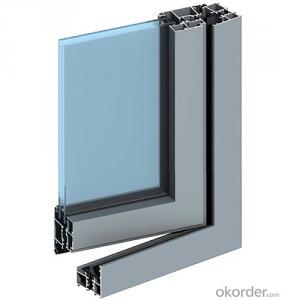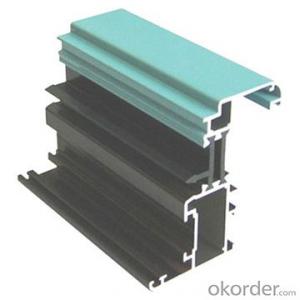Aluminum Extrusion Profiles Malaysia for Mill Finished Aluminium Profiles for Windows Frames
- Loading Port:
- Shanghai
- Payment Terms:
- TT OR LC
- Min Order Qty:
- 5 m.t.
- Supply Capability:
- 1000 m.t./month
OKorder Service Pledge
OKorder Financial Service
You Might Also Like
Specification
1. Structure of Mill Finished Aluminium Profiles for Windows Frames Description
Mill Finished Aluminium Profiles for Windows Frames is one semi-finished aluminium material. The alloy AA1050 is widly used in building, industry ect. Its weight is much lower than steel. So many customers choosed aluminium material instead of steel.
2. Specification of Mill Finished Aluminium Profiles for Windows Frames
Mill Finished Aluminium Profiles for Windows Frames | |
Main Specification | |
Alloy | AA1xxx (AA1050, AA1060, AA1070, AA1100 etc.) |
AA3xxx (AA3003, AA3004, AA3005, AA3105 etc.) | |
AA5xxx, AA6XXX (AA5052,AA5083, AA5754, AA6061, AA6062 etc.) | |
AA8xxx(AA8011, AA8006 etc.) | |
Temper | H14,H16, H18, H22, H24, H26, H32,O/F, T4, T6, T651 |
Thickmess | 0.01mm-100mm |
Width | 30mm-1700mm |
Standard | GB/T 3880-2006/ASTM |
Special specification is available on customer's requirement | |
3. Application of Mill Finished Aluminium Profiles for Windows Frames
(1).Interior: wall cladding, ceilings, bathrooms, kitchens and balconies, shutters, doors...
(2).Exterior: wall cladding, facades, roofing, canopies, tunnels,column covers , renovations...
(3).Advertisement: display platforms, signboards, fascia, shop fronts...
4. Feature of Mill Finished Aluminium Profiles for Windows Frames
Surfact Quality :
Be free from Oil Stain, Dent, Inclusion, Scratches, Stain, Oxide Dicoloration, Breaks, Corrosion, Roll Marks, Dirt Streaks and other defect which will interfere with use,
Mechenical Property:
Chemical Composite and Mechanical Property
5. Certificate of Mill Finished Aluminium Profiles for Windows Frames
SGS and ROHS(if client request, paid by client), MTC(plant provided), Certificate of Origin(FORM A, FORM E, CO), Bureau Veritas and SGS (if client request, paid by client), CIQS certificate
6. Image of Mill Finished Aluminium Profiles for Windows Frames



7. Package and shipping of Mill Finished Aluminium Profiles for Windows Frames
First, plastic cloth with drying agent inside; Second, Pearl Wool ; Third, wooden cases with dry agent , fumigation wooden pallets, aluminum surface could cover blue PVC film
8. FAQ
1) What is the delivery time?
Depends on actual order, around 20 to 35 days
2) What is the QC system:
We have QC staff of 20 persons and advanced equipment, each production is with MTC traced from Aluminum ingot lot.
3) What market do you mainly sell to?
Australia, America, Asia, Middle East, Western Europe, Africa etc
- Q: Fenglv aluminum material how ah? What aluminum materials do you use for windows and doors?
- Domestic aluminum quality is about the same, mainly you installed in the window accessories, is the key to the life of the service, recommend several brands Bar Reid Jan Ron Lixin spring is not recommended, quality is not very rely on live
- Q: Where is the aluminum profile market in Tianjin?
- Industrial aluminium profile standard profile:1530156015901640, 2020204020803030, 30R arc, 3030W 3030, 3030R, 3030RQ, 3060309030150, 4040A, 4040Q, 4040L4040W, 4040Z, 40R arc, 40 right angle, 4060Q, 4060L, 4060Z, 4080, 4080L, 4080W, 8080, 8080W, 606080120100100, 1201204012045454545L 4545Q 4545W 45909090 9090W 45R 4560 4560W 501005050501006060 6060L arc 4545RQ (1530-120120 Series) line industrial profiles and accessories can be assembled into processing products: tool rack (car), operation table, special tool cart, line table, product display, LCD panel, sun room, display cabinets, display rack, mechanical seal cover, shelves, product testing equipment, non-standard equipment, industrial fence, plotter, testing equipment, laboratory equipment, biological machine, labeling machine, production line, motor rotor bracket, electronic products production line, production line, line table, equipment protection barrier, LCD panel production equipment
- Q: Can aluminum profiles be custom-designed?
- Indeed, specific requirements and specifications can be catered to when it comes to aluminum profiles. This is because aluminum is an incredibly adaptable and pliable material, which makes it an excellent choice for customization purposes. A wide array of shapes, sizes, and configurations can be achieved when creating custom-designed aluminum profiles, ensuring they meet the unique demands of various industries and applications. The customization process often entails seeking guidance from experts who possess the expertise and know-how to design and manufacture aluminum profiles that align with the desired specifications. By opting for custom-designed aluminum profiles, one can benefit from their precise dimensions, distinctive shapes, and enhanced functionality, guaranteeing an impeccable fit for any given project.
- Q: Is it possible to use aluminum profiles for outdoor applications like fences and railings?
- <p>Yes, aluminum profiles are commonly used for outdoor applications such as fences and railings. They are favored for their resistance to corrosion, lightweight properties, and durability. Aluminum can withstand harsh weather conditions without rusting, making it an ideal material for outdoor use. Additionally, it is low maintenance, as it does not require painting or frequent repairs. The profiles can be powder-coated or anodized for enhanced protection and aesthetic appeal.</p>
- Q: Features of aluminum profiles
- Corrosion resistanceThe density of aluminum profile is only 2.7g/cm3, about 1/3 of steel, copper or brass (7.83g/, cm3, 8.93g/, cm3), respectively. Aluminum can show excellent corrosion resistance in most ambient conditions, including air, water (or brine), petrochemical, and many chemical systems nductivityAluminum profile is often chosen because of its excellent electrical conductivity. On the basis of equal weight, the conductivity of aluminum is nearly two times that of copper.
- Q: Are aluminum profiles resistant to chemicals and acids?
- Generally, aluminum profiles exhibit resistance to chemicals and acids due to their natural oxide layer, making them appropriate for diverse industrial uses. Nevertheless, the level of resistance may differ depending on the exact type of chemical or acid employed, as certain aggressive substances can still corrode aluminum. In these instances, one can enhance the resistance by applying supplementary protective coatings or surface treatments. To guarantee the utmost performance and durability, it is recommended to consult experts or manufacturers to ascertain the compatibility of aluminum profiles with specific chemicals or acids.
- Q: Can aluminum profiles be used in the production of transportation containers?
- Yes, aluminum profiles can be used in the production of transportation containers. Aluminum is a lightweight and durable material that is widely used in various industries, including transportation. It offers several advantages for container production, such as corrosion resistance, high strength-to-weight ratio, and ease of fabrication. Aluminum profiles can be used to construct the framework and walls of transportation containers, providing structural integrity while keeping the overall weight of the container low. Additionally, aluminum profiles can be easily customized and shaped to fit specific container requirements. Overall, the use of aluminum profiles in transportation container production offers numerous benefits and is a popular choice among manufacturers.
- Q: This question asks about the impact of aluminum profiles on the sound insulation properties of a building.
- <p>Aluminum profiles can significantly affect the sound insulation of a building. They are often used in construction for their strength and lightweight properties. However, aluminum is a good conductor of sound, which can lead to sound transmission through the building structure. To enhance sound insulation, aluminum profiles are often combined with soundproofing materials such as acoustic foam or rubber seals. These materials help to absorb or block sound waves, reducing noise transmission. Additionally, the design and installation of aluminum profiles can also impact sound insulation; proper sealing and insulation techniques are crucial to minimize sound leakage.</p>
- Q: How much is aluminum section ton?
- Aluminum prices are generally aluminum ingot + processing feesAluminum ingot to see whether you use LME or the South China Sea well-informed, or with the Yangtze River aluminum ingot prices?. Aluminum ingots generally float between 16000/ tons.Processing costs, the blank is generally 2500-3000/ tons, ordinary oxidation plus 1000 can be. If sprayed, add 500 on the basis of oxidation.
- Q: What are the design options for aluminum profiles?
- When it comes to aluminum profiles, there are numerous design options available, offering a wide range of applications and customization possibilities. Here are some commonly used design options for aluminum profiles: 1. Various Extrusion Shapes: Aluminum profiles can be extruded into different shapes, including square, rectangular, round, T-shaped, I-shaped, or custom profiles. This shape flexibility enables designers to create profiles that perfectly match their project requirements. 2. Diverse Surface Finishes: Aluminum profiles can be finished with various surface treatments to enhance their appearance and protect them from corrosion. Popular surface finishes include anodizing, powder coating, polishing, brushing, and laminating. These finishes offer a variety of colors, textures, and levels of glossiness to suit specific design preferences. 3. T-Slot Profiles: T-slot profiles are a type of aluminum extrusion with a T-shaped slot on one or more sides. These profiles are commonly used in constructing frameworks, machine guards, and other structures that require easy assembly and reconfiguration. The T-slot design facilitates convenient insertion and adjustment of connecting elements, such as bolts, nuts, and brackets. 4. Thermal Break Profiles: Thermal break profiles are designed with a thermal barrier inserted between the interior and exterior parts of the profile. This design minimizes the transfer of heat or cold between the two sides, making them suitable for applications where thermal insulation is crucial, such as windows, doors, and curtain walls. 5. Customization Options: Aluminum profiles can be further customized through additional machining processes, such as cutting, drilling, tapping, milling, or bending. These processes allow for the creation of unique shapes, hole patterns, or features that meet specific design requirements. 6. Integration Capability: Aluminum profiles can be designed to integrate with other components or systems, such as hinges, connectors, fasteners, or brackets. This integration capability provides flexibility in assembly and enables the creation of complex structures or modular systems. In summary, the design options for aluminum profiles are extensive, offering versatility, functionality, and aesthetic appeal. Designers have the freedom to choose from a wide range of shapes, finishes, and additional features to create aluminum profiles that precisely meet their project needs.
Send your message to us
Aluminum Extrusion Profiles Malaysia for Mill Finished Aluminium Profiles for Windows Frames
- Loading Port:
- Shanghai
- Payment Terms:
- TT OR LC
- Min Order Qty:
- 5 m.t.
- Supply Capability:
- 1000 m.t./month
OKorder Service Pledge
OKorder Financial Service
Similar products
Hot products
Hot Searches
Related keywords




























